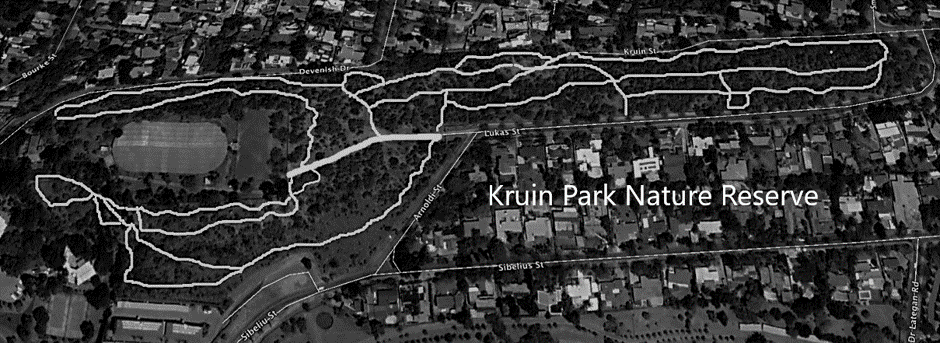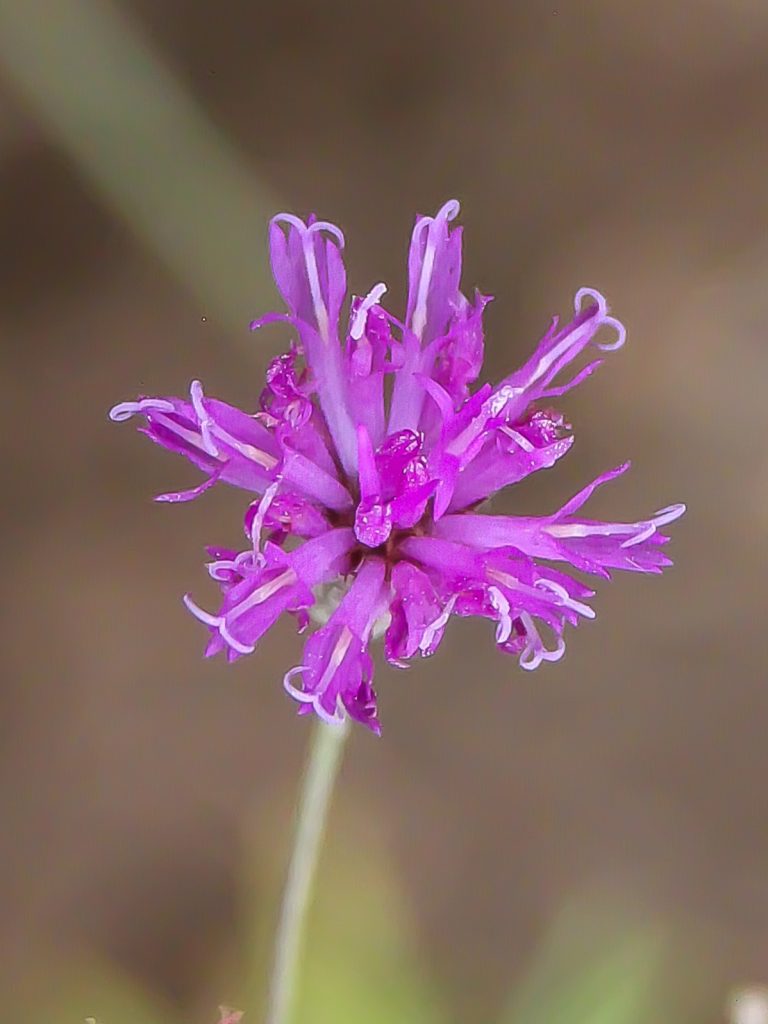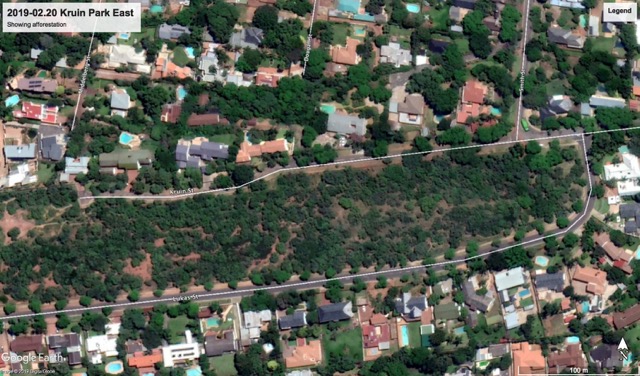
About Kruin Park
Kruin Park is a nine hectare Nature Reserve belonging to the City Of Tshwane and managed by their Nature Conservation division.
The park is situated on the Lukasrand and Muckleneuk Ridge in Pretoria.The ridges and grasslands of Gauteng are “Critically Endangered” and under constant threat of development as our cities grow. Preserving what natural areas we still have becomes hugely important. That includes every nature reserve in the city. Small reserves like Kruin Park and Colbyn Valley are just as valuable as the larger reserves like Rietvlei, Faerie Glen and Groenkloof. Kruin Park is a fine example of the ridges and grasslands of Gauteng. Its value in preserving our natural environment far exceeds its recreational value.
Kruin Park is used mostly by this community, for walking (with or without dogs), picnics and bird watching. The indigenous trees and grasses and beautiful views make it a very special and unique park.
Kruin Park on Google Maps
Kruin Park’s address is:

Open and Closing times
Kruin Park’s gates are unlocked during the day and locked at night. No one is allowed in the Park at night.
May to August (Winter months):
07h00 to 18h00
September to April (Summer months):
06h30 to 18h30
Entry to Kruin Park
Kruin Park can be accessed via any of the 7 gates situated around the park.
- Gate 1 is the big Reservoir gate on the corner of Lukas and Arnoldi Streets, Lukasrand.
- Gate 2 is the small gate next to gate 1
- Gate 3 is in Lukas Street, Lukasrand.
- Gate 4 is at the eastern end of the reserve in the groomed park section by Smith, Lukas and Kruin Streets.
- Gate 5 is at the Kruin Street dead end.
- Gate 6 is in Devenish Drive at the top of Loveday Street, Muckleneuk.
- Gate 7 is in Devenish Drive at the western end of the Park.
Contact Phone Numbers for Tshwane Nature Conservation
012 358-1757
012 358-1753
012 358-8188



Rules
Outside Gates 1, 5 and 6 and in Sibelius Road there are signs which give us information about the park including the opening times, and the general rules for its use. These are determined by the Department of Nature Conservation.
The following activities are allowed in Kruin Park:
- Bird watching
- Walking
- Walking dogs on leads
- Clear up dog mess
- Picnics
- Put litter in bins provided or remove from the park
The following activities are not allowed in Kruin Park:
- No fires
- No braais
- No cycling
- No loud noise
- No chopping of wood or cutting plants
- No guns
- No dumping
- No picking flowers or seeds
- No littering
- No dog mess
Two common violations that are really harming the Park are:
Walking dogs off a lead. The city’s By-law pertaining to Public Amenities states that all dogs should be kept on a leash in public areas. The city’s Nature Conservation staff are applying the rule strictly, given the risk to bird life of dogs running uncontrolled through the park.
Littering. Apart from the visual pollution, litter can harm birds and small animals that live in the park.
If you see any violations to the rules please phone Nature Conservation, security, Metro Police or the Friends of Kruin Park.
Climate
The microclimate of the site is interesting in that both a slight northern and a slight southern aspect is present, resulting in different vegetation communities. This diversity is rare in so small a site in a city context.
Geology and soils
According to Prof. G.J. Bredenkamp (1999) the larger western portion of the site is underlain by shale of the Timeball Hill series, while the eastern hill is composed of quartzite of the same series. The surface condition is very rocky with shallow-reddish-brown-sandy-loam-soil, mostly of the Mispah or Glenrosa form. Shallow soil such as these are subject to erosion if the vegetation cover is allowed to degrade.
Topography and Hydrology
Regionally the site forms part of the Bronberg Ridge, which is part of a series of east-west orientated ridges that characterize the topography of the Pretoria area.
Locally, the site is situated in a linear position along the crest of the Lukasrand Ridge. Natural drainage has been disturbed on all sides of the site due to development in these areas. The site drops 10-15m from the highest pointing the west to the lowest points in the east and south.
Regional scale
Kruin Park represents the eastern extremity of a system of open space that begins with Kwaggasrand and extends eastward along the Langeberge, over Weskop, magazine Hill, Salvokop, Bourkes Hill and finally Lukasrand. The system also extends to the south over Skanskop, Klapperkop and the Groenkloof Nature Reserve. Many of these ridges have been conserved and some areas have been developed. Visually, the system is perceived as continuous open space. All of the undeveloped component sites, especially those penetrating the city’s urban fabric such as Kruin Park, are therefore of great significance within the urban structure.
Local scale
The crest of the ridge to the west of the site houses a reservoir and the Post and Telecommunications Tower beyond. Both these developments, although not publicly accessible, are perceived as visual open space.
Visual realm
The distant views from the site are impressive and extend as far as Meintjieskop and the Magliesberg beyond to the north and Klapperkop and Groenkloof nature Reserve to the south.
Flora and fauna
This website extensively lists the plants and trees found in the reserve. The information below is from the Environmental study done in April 1999 and Mark Theron. This is a snapshot of what the Park was like at this time.
Vegetation
According to a vegetation assessment conducted by Prof. G.J. Bredenkamp (1999) the area is covered with dense mountain bushveld in good condition. The site lies close to the southernmost tip of its vegetation type. The vegetation mostly represents a crest plant community, with traces of north and south slope communities.
Bushveld of this quality is very rare in the Pretoria city environment and the site, is considered to be of great conservation value.
Vegetation on shale
The vegetation of the largest (western) part of the site occurs on shale.
The woody component is dominated by Combretum molle and Acacia Caffra and in total 21 species are present.
The site also has some indigenous tree species, not naturally occurring on the site as well as some exotic species.
The grass layer is well represented in the open area between the trees and 18 species were observed.
There are a number of other herbaceous species (21).
Vegetation on Quartzite
A small, elevated quartzite area is situated in the eastern portion. This vegetation is dominated by Combretum molle and Rhus leptodictya. Most species mentioned may occur here. Some species are restricted to this quartzite.
The central part of the reserve has quartzite outcrops with the presence here and there of Euphorbia schinzii.
The Northern face of the reserve along Devenish Drive is quartzite.
Fauna
It is assumed that the good condition of the vegetation and the quiet surroundings contribute to thriving bird and insect communities. Reptiles such as snakes and lizards are bound to be plentiful, as are small rodent species. A number of small mammals have been cited in the reserve.



History
The following was written by Mark Theron on 23 April 2014 to promote a walk he was leading:
Some 118 years ago President Paul Kruger of the former Republiek van Zuid-Afrika was persuaded of the need for a game sanctuary on the southern outskirts of Pretoria. This would protect the timid and elusive Oribi and other game that was being wiped out by hunters. And so on 25 February 1895 the Groenkloof Nature Reserve was proclaimed, the first in Africa.
The development of Pretoria has led to the loss of land for a variety of other uses including, UNISA, the SABS, the suburbs of Groenkloof and Lukasrand, but most of the land is still preserved for future generations. The largest portion of the original reserve is still called the Groenkloof Nature Reserve and it includes the well-known Fountains Valley.
We are fortunate to have a nine hectare piece of the reserve here on our doorstep, Kruin Park.
Some seventy years ago, while John Edmund (“Jack”) Repton who would later become the Director of Parks in Pretoria was still a Parks Superintendent, he recognised the beauty and charm of the open space on the top of Muckleneuk Hill and he put a team of workers to work establishing a stone path from the eastern end of the park to encourage you and me to walk in the park. This project was never fully completed, but about 200 metres of well-constructed stone path remain clearly visible and there are some short stretches of stone path, one of which has been uncovered and tidied up and at least one other still to be hunted down. Where the main stone path ends a simple path continues for another 300 metres.
In recognition of Repton’s work in the city, the City Council of Pretoria decided to name a park after him and when approached he chose the nine hectare piece of nature we call Kruin Park. The park was officially named the Jack Repton Park by the then City Council. The name has fallen into disuse and our much-loved and very popular park is now simply Kruin Park.
By 2002 a rough road went through the park from the end of the cul-de-sac in Kruin Street and doubling back to the entrance in Lukas Street. The road was extensively used by people wanting to dump their rubbish. Around 2003 the fence around the park was upgraded by Tshwane Nature Conservation and the large scale dumping came to an end. Anyone who used the park then will recognise where that road went but it is no longer recognisable as a road now.
Seven or eight residents of Muckleneuk met early in 2005 and decided to establish an organisation we called the “Friends of Kruin Park” and we have held a number of clean-up operations in the park since then.
In about 2006, troubled by the spread of invasive plants in Kruin Park, Mark Theron offered to undertake selective spraying of Lantana, Pompom, Cat’s Claw and other weeds in the park. This has continued since then with the blessing of the Nature Conservation Division.
Wanting to get to weeds in the less accessible north-eastern part of the park, Mark opened up a narrow temporary path. Although it was barely visible, someone noticed it and started to walk it. Soon it was a well-used path and the City of Tshwane gave its stamp of approval by widening the path with brush cutters.
In 2011 Mark started a similar access path that continues the original “Jack Repton Path” and this too is now a well-used favourite of many.
In 2014 Mark created a scenic path on the southern side of the Muckleneuk Water Reservoir and re-opened a path on the northern side of the reservoir close to the Devenish Drive fence.
Apart from offering some of the most attractive walks in the city, Kruin Park has a wonderfully varied bird life. There have been regular sightings of the Southern Lesser Galago (Bushbaby) leaping through the trees at dusk as well as Slender Mongooses. The fiery-necked Nightjar is also heard fairly regularly.
